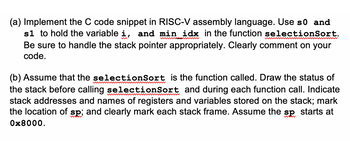
Database System Concepts
7th Edition
ISBN: 9780078022159
Author: Abraham Silberschatz Professor, Henry F. Korth, S. Sudarshan
Publisher: McGraw-Hill Education
expand_more
expand_more
format_list_bulleted
Question
For the whole question, pseudo-instructions are not allowed except “j target_label”
and “jr ra”. One suggestion for assembly
comments to one or a block of instructions.
Question a and b regarding the pictures attached below

Transcribed Image Text:(a) Implement the C code snippet in RISC-V assembly language. Use so and
s1 to hold the variable i, and min idx in the function selectionSort.
Be sure to handle the stack pointer appropriately. Clearly comment on your
code.
(b) Assume that the selectionSort is the function called. Draw the status of
the stack before calling selectionSort and during each function call. Indicate
stack addresses and names of registers and variables stored on the stack; mark
the location of sp; and clearly mark each stack frame. Assume the sp starts at
0x8000.
![4.
void swap (int *xp, int *yp)
{
Consider the following C code snippet.
int temp = *xp;
*xp
*yp;
*yp = temp;
}
int findMinimum (int arr[], int N)
{
}
// variable to store the index of minimum element
int min_idx = 0;
int min_E =
// Traverse the given array
for (int i = 1; i < N; i++) {
// If current element is smaller than min_idx then update it
if (arr[i] < min_E) {
min idx = i;
min_E = arr [min_idx];
}
arr [min_idx];
}
return min_idx;
}
/* Function to sort an array using selection sort*/
void selectionSort (int arr[], int n)
{
int i, min_idx;
// One by one move boundary of unsorted subarray
for (i = 0; i < n-1; i++)
{
// Find the minimum element in unsorted array
min_idx = findMinimum (&arr[i], n-i);
// Swap the found minimum element with the first element
if (min_idx != 0)
swap (&arr [min_idx+i], &arr[i]);](https://content.bartleby.com/qna-images/question/c954a0cb-c6cd-409f-94c9-db9ed3cb3c10/a8b1bb07-d281-45bb-84cf-b126dd12919a/02zixlc_thumbnail.png)
Transcribed Image Text:4.
void swap (int *xp, int *yp)
{
Consider the following C code snippet.
int temp = *xp;
*xp
*yp;
*yp = temp;
}
int findMinimum (int arr[], int N)
{
}
// variable to store the index of minimum element
int min_idx = 0;
int min_E =
// Traverse the given array
for (int i = 1; i < N; i++) {
// If current element is smaller than min_idx then update it
if (arr[i] < min_E) {
min idx = i;
min_E = arr [min_idx];
}
arr [min_idx];
}
return min_idx;
}
/* Function to sort an array using selection sort*/
void selectionSort (int arr[], int n)
{
int i, min_idx;
// One by one move boundary of unsorted subarray
for (i = 0; i < n-1; i++)
{
// Find the minimum element in unsorted array
min_idx = findMinimum (&arr[i], n-i);
// Swap the found minimum element with the first element
if (min_idx != 0)
swap (&arr [min_idx+i], &arr[i]);
Expert Solution
This question has been solved!
Explore an expertly crafted, step-by-step solution for a thorough understanding of key concepts.
This is a popular solution
Trending nowThis is a popular solution!
Step by stepSolved in 4 steps

Knowledge Booster
Learn more about
Need a deep-dive on the concept behind this application? Look no further. Learn more about this topic, computer-science and related others by exploring similar questions and additional content below.Similar questions
- The interrupt vector table contains items that each represent a different collection of details.?arrow_forwardExplain the code solution to this problem in a step-by-step way. The steps should be described in English, and it should explain each part of the code step by step.arrow_forwardExample: The Problem Input File Using C programming language write a program that simulates a variant of the Tiny Machine Architecture. In this implementation memory (RAM) is split into Instruction Memory (IM) and Data Memory (DM). Your code must implement the basic instruction set architecture (ISA) of the Tiny Machine Architecture: //IN 5 //OUT 7 //STORE O //IN 5 //OUT 7 //STORE 1 //LOAD O //SUB 1 55 67 30 55 67 1 LOAD 2- ADD 3> STORE 4> SUB 5> IN 6> OUT 7> END 8> JMP 9> SKIPZ 31 10 41 30 //STORE O 67 //OUT 7 11 /LOAD 1 //OUT 7 //END 67 70 Output Specifications Each piece of the architecture must be accurately represented in your code (Instruction Register, Program Counter, Memory Address Registers, Instruction Memory, Data Memory, Memory Data Registers, and Accumulator). Data Memory will be represented by an integer array. Your Program Counter will begin pointing to the first instruction of the program. Your simulator should provide output according to the input file. Along with…arrow_forward
arrow_back_ios
arrow_forward_ios
Recommended textbooks for you
 Database System ConceptsComputer ScienceISBN:9780078022159Author:Abraham Silberschatz Professor, Henry F. Korth, S. SudarshanPublisher:McGraw-Hill Education
Database System ConceptsComputer ScienceISBN:9780078022159Author:Abraham Silberschatz Professor, Henry F. Korth, S. SudarshanPublisher:McGraw-Hill Education Starting Out with Python (4th Edition)Computer ScienceISBN:9780134444321Author:Tony GaddisPublisher:PEARSON
Starting Out with Python (4th Edition)Computer ScienceISBN:9780134444321Author:Tony GaddisPublisher:PEARSON Digital Fundamentals (11th Edition)Computer ScienceISBN:9780132737968Author:Thomas L. FloydPublisher:PEARSON
Digital Fundamentals (11th Edition)Computer ScienceISBN:9780132737968Author:Thomas L. FloydPublisher:PEARSON C How to Program (8th Edition)Computer ScienceISBN:9780133976892Author:Paul J. Deitel, Harvey DeitelPublisher:PEARSON
C How to Program (8th Edition)Computer ScienceISBN:9780133976892Author:Paul J. Deitel, Harvey DeitelPublisher:PEARSON Database Systems: Design, Implementation, & Manag...Computer ScienceISBN:9781337627900Author:Carlos Coronel, Steven MorrisPublisher:Cengage Learning
Database Systems: Design, Implementation, & Manag...Computer ScienceISBN:9781337627900Author:Carlos Coronel, Steven MorrisPublisher:Cengage Learning Programmable Logic ControllersComputer ScienceISBN:9780073373843Author:Frank D. PetruzellaPublisher:McGraw-Hill Education
Programmable Logic ControllersComputer ScienceISBN:9780073373843Author:Frank D. PetruzellaPublisher:McGraw-Hill Education

Database System Concepts
Computer Science
ISBN:9780078022159
Author:Abraham Silberschatz Professor, Henry F. Korth, S. Sudarshan
Publisher:McGraw-Hill Education

Starting Out with Python (4th Edition)
Computer Science
ISBN:9780134444321
Author:Tony Gaddis
Publisher:PEARSON

Digital Fundamentals (11th Edition)
Computer Science
ISBN:9780132737968
Author:Thomas L. Floyd
Publisher:PEARSON

C How to Program (8th Edition)
Computer Science
ISBN:9780133976892
Author:Paul J. Deitel, Harvey Deitel
Publisher:PEARSON

Database Systems: Design, Implementation, & Manag...
Computer Science
ISBN:9781337627900
Author:Carlos Coronel, Steven Morris
Publisher:Cengage Learning

Programmable Logic Controllers
Computer Science
ISBN:9780073373843
Author:Frank D. Petruzella
Publisher:McGraw-Hill Education